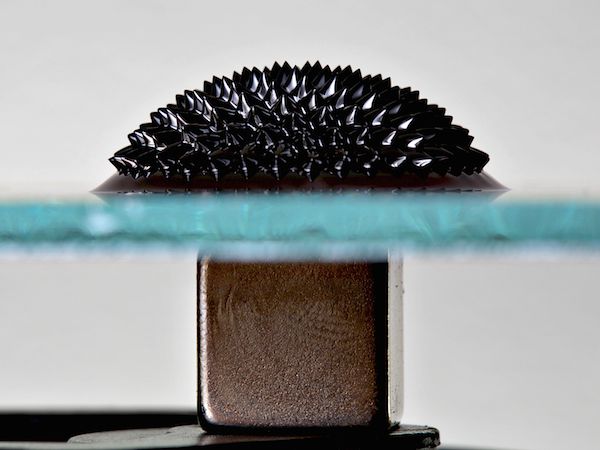
[Image above] A ferrofluid atop glass reacts to a rare-earth magnet cube below. Credit: Gregory F. Maxwell; Wikimedia Commons CC BY-SA 3.0
The rare earth market is a big one, thanks in part to the use of these materials in nearly everything high-tech—tablets, TVs, smartphones, medical devices, batteries, permanent magnets, and much more.
Demand for permanent magnets alone is predicted to double from 2012 to 2020, according to a Grandview Research market report on rare earths. And an estimated 2012 rare earth market value of $4.3 billion is predicted to increase to $10.9 billion by 2020.
China already supplies the majority of the world’s rare earths. And with the near-inevitable fall of yet another U.S.-based miner predicted to happen soon, China is about to help itself to an even bigger slice of that profitable pie.
But doesn’t anyone else want some pie?
According to a Bloomberg Business article, Chile is hungry for dessert.
Chile’s clays contain similar concentrations of rare earths as the soils of Southern China, according to the article. [However, results from the U.S. Geological Survey seem to disagree, at least in overall available rare-earths deposits.]
Mining and recovering rare earths is a laborious process that can take a significant environmental toll. But mining company Mineria Activa wants to change that with a new project set to offer green rare earths—Minera Biolantánidos.
Biolantánidos is pioneering a patent-pending process of extracting rare earths from clay using a tank-leaching process with biodegradable chemicals. And the company is betting big that companies will pay a premium for the ability to offer cutting-edge technology with a clear environmental conscious.
Credit: Minera BioLantánidos; Youtube
The process involves digging up the rare-earth laden Chilean soil and placing it in large in-ground tanks for leaching out valuable elements using the biodegradable chemicals.
After the rare earths are collected, the rare earth-free clay is returned to the ground and a fresh forest of trees planted on top.
That means no toxic waste and no dystopian tailing ponds—and no money dealing with that waste. Although the chemicals are expensive, the savings on the waste side of the process help balance the cost, project leader Arturo Albornoz says in the Bloomberg article.
“It may be laborious, but Albornoz is hoping companies such as ThyssenKrupp AG, Apple Inc. and Tomahawk cruise missile maker Raytheon Co. will end up paying a premium, knowing their suppliers aren’t destroying the planet,” the article continues.
Biolantánidos already has a pilot plant well underway, so we’ll have to keep tabs on the effort to see how it pans out.

An aerial view of leaching tanks at the BioLantánidos pilot project. Credit: Minera BioLantánidos; Youtube
Along with the big business of mining rare earths also comes a big business of recycling rare earths, too—a topic we’ve covered on CTT before, including here, here, and here.
But with the growing piles of electronics waste, it’s a topic that’s also growing even more urgent.
Computers and TVs—both of which make heavy use of liquid crystal display (LCD) screens—are replaced in the typical household about every five years each. And a dismal proportion of those discarded devices are recycled.
Rare-earth element indium is an essential component in those eye-catchingly crisp LCDs, which means that a large collective amount of indium is simply tossed in the trash.
Researchers from Tsinghua University, China, are hoping to up the amount of indium recycled from LCDs with the help of a new paper published in ACS Sustainable Chemistry & Engineering that analyzes the most effective recycling methods.
The paper’s introduction states “China, for instance, will generate approximately 100 million units of e-waste of televisions, personal computers, and laptop computers from 2014 to 2020. On the other hand, approximately 55% to 85% of global indium has been utilized in LCDs as indium–tin oxide (ITO) films. It is reported that at least 80%—in fact, more than 90% in 2013—of the global indium production was used for ITO.”
And with the current rate of electronics disposal, recycling of this rare earth element will soon become a necessity to keep pace with society’s consumption of new technology.
The Tsinghua team extensively tested the best ways to recover the rare-earth element from LCD screen glass, experimenting with indium recovery through 18 different leaching experiments.
Their endeavors tested varying ratios, concentrations, temperatures, times, sample sizes, leaching agents, and oxidants throughout the process.
According to an American Chemical Society release, “the most effective technique involved crushing and grinding LCD glass into particles less than 75 μm, or 0.003 in., in size and bathing them in a sulfuric acid solution at 122 °F.”
For further details, the paper is “Recycling indium from scraped glass of liquid crystal display: Process optimizing and mechanism exploring” (DOI: 10.1021/acssuschemeng.5b00020).

